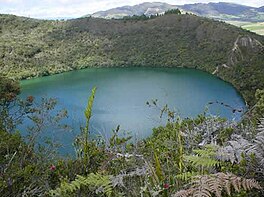Lake Guatavita
| Laguna Guatavita | |
|---|---|
 | |
| Location | Sesquilé, Cundinamarca, Colombia |
| Coordinates | 4°58′39.4″N 73°46′30.0″W / 4.977611°N 73.775000°W |
| Max. length | 700 metres (2,300 ft) |
| Max. width | 700 metres (2,300 ft) |
| Surface area | 19.8 ha (49 acres) |
| Max. depth | 125 metres (410 ft) |
| Surface elevation | 3,000 m (9,800 ft) |
| References | [1][2][3] |

Lake Guatavita (Spanish: Laguna Guatavita) is located in the
.The lake is circular and has a surface area of 19.8 hectares. The earlier theories of the crater's origin being a meteorite impact, volcanic cinder, or limestone sinkhole are now discredited. The most likely explanation is that it resulted from the dissolution of underground salt deposits from an anticline,[3] resulting in a kind of sinkhole.
There are hot springs nearby in the municipality of Sesquilé, which means "hot water" in the now-extinct language of Chibcha, once spoken by the local indigenous people, the Muisca.
Spanish colonizers and
The lake is now a focus of ecotourism, and its association with the legend of El Dorado is also a major attraction.
Etymology
The name of the lake is derived from Chibcha, the language of the Muisca: gwa: mountain or gwata, gwate: high elevation, or gwatibita: high mountain peak; hence, a pool at a high mountain peak.[5] Another meaning is "End of the farmfields".[6]
Muisca mythology
Lake Guatavita was reputedly one of the
Trivia
- Lake Guatavita is the filming location of the Fanny Lú
See also
- Muisca religion
- Guatavita myth
- Lake Iguaque, another sacred lake of the Muisca
- Siecha Lakes, other lakes implicated in the El Dorado legend
- Tominé Reservoir, which buried the old town of Guatavita
- Tunjo, offer pieces in Lake Guatavita
- Gold Museum, Bogotá, where archaeological objects from the lake are displayed
References
- ^ (in Spanish) Google Maps Area Calculator
- ^ (in Spanish) Google Maps Elevation Finder
- ^ .
- ^ British Museum Collection
- ^ M. Louis Ghisletti, Los Mwiskas, Bogota, 1954
- ^ (in Spanish) Official website Guatavita Archived 2016-01-30 at the Wayback Machine
External links
 Media related to Laguna de Guatavita at Wikimedia Commons
Media related to Laguna de Guatavita at Wikimedia Commons- (in Spanish) Lake Guatavita - Colparques

